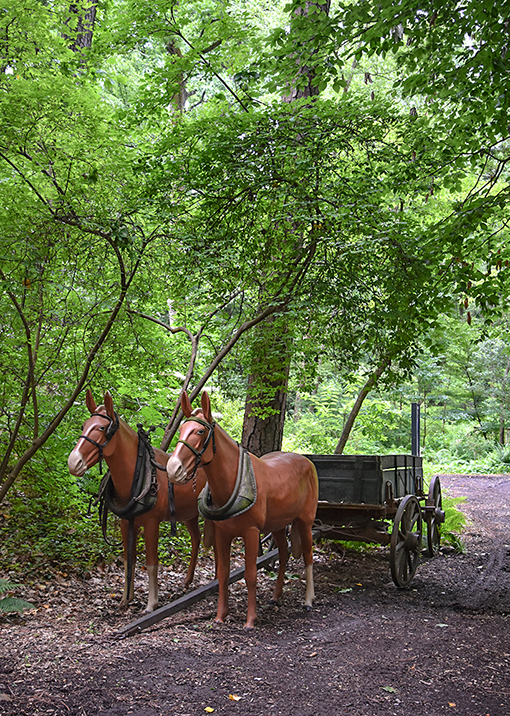 |
| Quarry Garden | Atlanta History Center | Photo by Travis Swann Taylor |
This three-acre garden is full of surprises, including these two horses and a wagon!
There are several entrances to this garden and there's a bridge overhead that connects the museums building to the Swan House offering a great vista of the Quarry Garden.
The Buckhead branch of Peachtree Creek runs along the southern side of the quarry and is rumored to be the location where Henry Irby, a general store and tavern owner, killed a buck and mounted its horns in his nearby tavern. The tavern came to be known as Buck’s Head, which later became the entire area’s name—Buckhead.
The Mary Howard Gilbert Memorial Quarry Garden was dedicated in 1976 and named in honor of a founding member of the Mimosa Garden Club, which coincidentally was founded the same year the the Swan House was built—1928. The club remains actively involved in the care and improvement of the the Quarry Garden.
The two stainless steel deer sculptures you'll spy in this garden are Key deer. This endangered species is found only in the lower Florida Keys. These were created by Georgia artist Thomas Prochnow in 2002 and were donated to the Atlanta History Center by the Poppy Garden Club in 2003. Prochnow's studio is in the city of Buckhead about 1.5 hours east of the Atlanta History Center.
Signage throughout this garden is shared through the lens of botany and/or Native American culture, including one about the many uses of deer. Native Americans are known for their respect for and harmony with nature, thus every part of a kill was used in some manner.
Did I mention the rare species you'll find in this garden? You'll see the rare Franklin Tree (Franklinia alatamaha), believed to be extinct in the wild. The Franklin Tree here is also Georgia's Champion Franklin Tree—the largest of its species in the state!
There are hundreds of species of plants in this garden, including the pawpaw tree (Asimina triloba), which are the largest edible fruit trees native to North America, particularly in temperate climates in the eastern United States. Lewis and Clark noted in their journals that they survived for a period of their 1806 expedition on pawpaw fruit when other supplies ran low.
There's a native species bog garden here, too. It's so lush in the long growing season we have in Atlanta that you might not see it except for the tell-tale aquatic plant species, that and a sculpture of a particular water fowl.
Keep an eye out for the placards placed throughout the garden. They will tell you what you're looking at, that it might be rare, used as medicine, or even poisonous.
With so much to explore here, if you find you need a rest or just want a little time to sit and reflect, there are multiple benches in the garden, some isolated and one perched slightly above the quarry's bed.
When you next visit the Atlanta History Center's gardens, be sure to stop by the Mary Howard Gilbert Memorial Quarry Garden. It's truly a delightful adventure of discovery!
The Other Gardens: This is the fourth post in a series sharing the beauty of the nine gardens on the Atlanta History Center's 33-acre campus. You can find them all here.









No comments:
Post a Comment